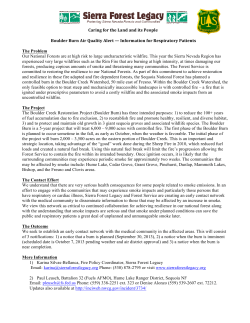
Smokefree Cars Frequently Asked Questions
Smokefree Cars Frequently Asked Questions What is the new smokefree car law? Effective January 1, 2014, Senate Bill 444 A makes smoking in a motor vehicle with a minor under the age of 18 present a secondary traffic violation. What is the purpose of the law? The primary goal of the law is to decrease children’s exposure to secondhand smoke in the small, enclosed area of a car. A secondary goal is to educate parents and other adults about the dangers of smoking in a car with a minor present. According to the Oregon Health Authority, children in an estimated 50,000 Oregon families are currently exposed to secondhand smoke in motor vehicles. What is the fine for violations of the law? Individuals can be fined up to $250 for first offense and up to $500 for second or subsequent offenses for smoking in a vehicle when youth are present. Who has the authority to enforce the law? A police officer may enforce this law only if they have already stopped the driver operating the vehicle for a separate traffic violation or other offense. Are there other jurisdictions that have prohibited smoking in vehicles? Yes, it is a growing movement—five other states have already passed similar policies aimed at reducing involuntary secondhand smoke exposure: Utah-under age 15 (May 2013) Arkansas-under age 14 (July 2011) Maine-under age 16 (September 2008) California-under age 18 (January 2008) Louisiana-under age 13 (August 2006) *Nine additional cities or counties have also passed similar policies Does it make a difference if I roll down my window when smoking? Unfortunately, no—opening a car window does not protect passengers from dangerous levels of secondhand smoke. A 2006 Harvard School of Public Health study found that whether the window was open slightly or wide open, secondhand smoke levels exceeded the EPA’s Air Quality Index.i Who supported this law? Many groups and individuals support smokefree cars for kids. Supporting groups included: the American Lung Association in Oregon, Oregon Pediatrics Society, Oregon Medical Association, American Heart Association, the Tobacco Free Coalition of Oregon, and others. In a 2011 Oregon Tobacco Survey, 82 percent of adults with children report having rules against smoking in the car. Additionally, 60 percent of Oregonians are in favor of prohibiting smoking in privately owned vehicles. The Science Behind the Law Environmental Protection Agency (EPA) Secondhand smoke is classified by the EPA as a Group A carcinogen. This classification is reserved for those mixtures which have been shown in studies to cause cancer in humans. Group A carcinogens also include arsenic and asbestos. According to the EPA, secondhand smoke in cars can be especially harmful to children because cars are small, confined spaces where children are closer to the smoker and the smoke. While a child’s lungs are still developing, they can be easily damaged by exposure to the high level of secondhand smoke in a car. Even though many smokers choose to open a window or increase the ventilation, the child passenger is still not fully protected. Secondhand smoke lingers long after the smoking stops.ii U.S. Surgeon General’s Report: The Health Consequences of Involuntary Exposure to Tobacco Smoke The 2006 Surgeon General’s Report reveals that secondhand smoke causes disease in children. Children exposed to secondhand smoke are at an increased risk for acute respiratory infections, ear problems, and more severe asthma. The Report also states that the scientific evidence about the dangers of secondhand smoke is clear: there is no safe level of exposure to secondhand smoke.iii Pollutant Concentration from Secondhand Smoke in a Vehicle According to a California Air Resources Board study, secondhand smoke in motor vehicles can be up to 27 times more concentrated than in a smoker’s home.iv In addition, by the time it takes to smoke half a cigarette, the air quality in a parked car can reach up to 10 times the hazardous level on the EPA’s Air Quality Index. Whether the car is moving or parked, the windows opened or cracked, the air quality level remains in the hazardous zone, with smoke often pooling in the back seat.v i Harvard School of Public Health. Measuring Air Quality to Protect Children from Secondhand Smoke in Cars, available at: http://www.ajpm-online.net/webfiles/images/journals/amepre/1751.pdf [visited on 6-28-13] ii Environmental Protection Agency. The Health Effects of Exposure to Secondhand Smoke, available at http://www.epa.gov/smokefree/healtheffects.html [visited on 6-21-13] iii U.S. Department of Health and Human Services, The Health Consequences of Involuntary Exposure to Tobacco Smoke: A Report of the Surgeon General, 2006, available at: http://www.surgeongeneral.gov/library/reports/secondhandsmoke/index.html. iv California Environmental Protection Agency, California Air Resources Board, Proposed Identification of Environmental Tobacco Smoke as a Toxic Air Contaminant (2005), available at: http://www.arb.ca.gov/toxics/ets/vehicle_ets.htm [visited on 6-21-13] v Video: Smoke-free Cars with Kids: A Scientific Demonstration of Secondhand Smoke Exposure, produced by the California Tobacco Control Program, 2008, available at: http://vimeo.com/1513382 [visited on 6-21-13] Adapted for use with the permission of the California Department of Public Health, California Tobacco Control Program © 2013 Updated September 2013
© Copyright 2025





















